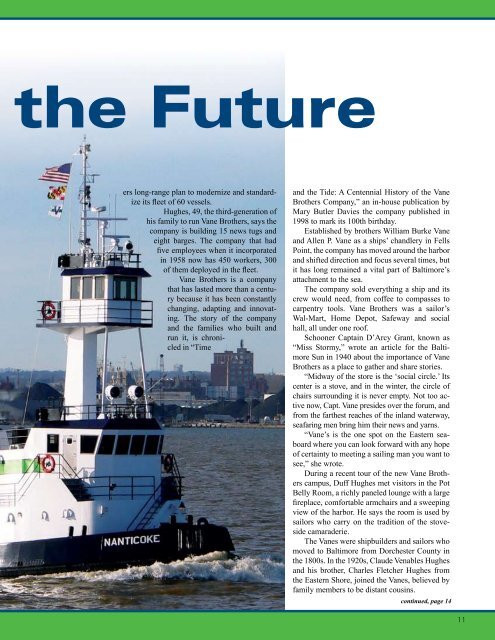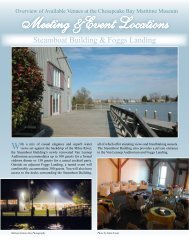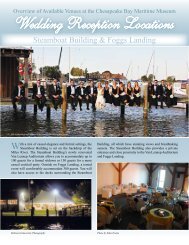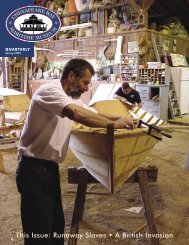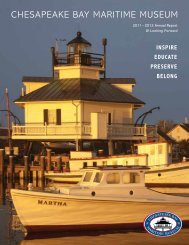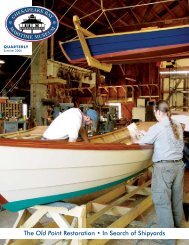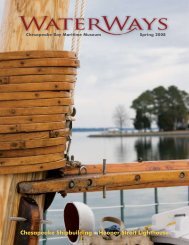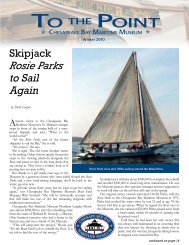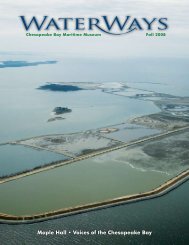Pocomoke Shipbuilding • Vane Brothers - Chesapeake Bay ...
Pocomoke Shipbuilding • Vane Brothers - Chesapeake Bay ...
Pocomoke Shipbuilding • Vane Brothers - Chesapeake Bay ...
Create successful ePaper yourself
Turn your PDF publications into a flip-book with our unique Google optimized e-Paper software.
the Future<br />
ers long-range plan to modernize and standardize<br />
its fleet of 60 vessels.<br />
Hughes, 49, the third-generation of<br />
his family to run <strong>Vane</strong> <strong>Brothers</strong>, says the<br />
company is building 15 news tugs and<br />
eight barges. The company that had<br />
five employees when it incorporated<br />
in 1958 now has 450 workers, 300<br />
of them deployed in the fleet.<br />
<strong>Vane</strong> <strong>Brothers</strong> is a company<br />
that has lasted more than a century<br />
because it has been constantly<br />
changing, adapting and innovating.<br />
The story of the company<br />
and the families who built and<br />
run it, is chronicled<br />
in “Time<br />
and the Tide: A Centennial History of the <strong>Vane</strong><br />
<strong>Brothers</strong> Company,” an in-house publication by<br />
Mary Butler Davies the company published in<br />
1998 to mark its 100th birthday.<br />
Established by brothers William Burke <strong>Vane</strong><br />
and Allen P. <strong>Vane</strong> as a ships’ chandlery in Fells<br />
Point, the company has moved around the harbor<br />
and shifted direction and focus several times, but<br />
it has long remained a vital part of Baltimore’s<br />
attachment to the sea.<br />
The company sold everything a ship and its<br />
crew would need, from coffee to compasses to<br />
carpentry tools. <strong>Vane</strong> <strong>Brothers</strong> was a sailor’s<br />
Wal-Mart, Home Depot, Safeway and social<br />
hall, all under one roof.<br />
Schooner Captain D’Arcy Grant, known as<br />
“Miss Stormy,” wrote an article for the Baltimore<br />
Sun in 1940 about the importance of <strong>Vane</strong><br />
<strong>Brothers</strong> as a place to gather and share stories.<br />
“Midway of the store is the ‘social circle.’ Its<br />
center is a stove, and in the winter, the circle of<br />
chairs surrounding it is never empty. Not too active<br />
now, Capt. <strong>Vane</strong> presides over the forum, and<br />
from the farthest reaches of the inland waterway,<br />
seafaring men bring him their news and yarns.<br />
“<strong>Vane</strong>’s is the one spot on the Eastern seaboard<br />
where you can look forward with any hope<br />
of certainty to meeting a sailing man you want to<br />
see,” she wrote.<br />
During a recent tour of the new <strong>Vane</strong> <strong>Brothers</strong><br />
campus, Duff Hughes met visitors in the Pot<br />
Belly Room, a richly paneled lounge with a large<br />
fireplace, comfortable armchairs and a sweeping<br />
view of the harbor. He says the room is used by<br />
sailors who carry on the tradition of the stoveside<br />
camaraderie.<br />
The <strong>Vane</strong>s were shipbuilders and sailors who<br />
moved to Baltimore from Dorchester County in<br />
the 1800s. In the 1920s, Claude Venables Hughes<br />
and his brother, Charles Fletcher Hughes from<br />
the Eastern Shore, joined the <strong>Vane</strong>s, believed by<br />
family members to be distant cousins.<br />
continued, page 14<br />
11


